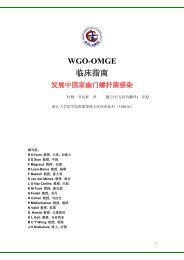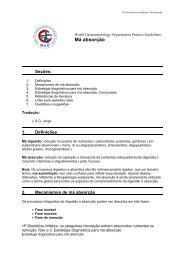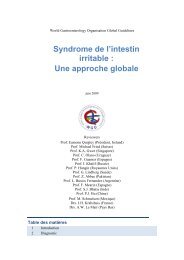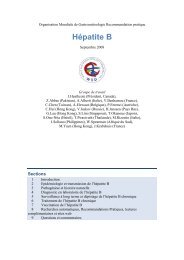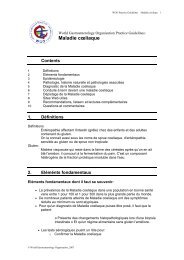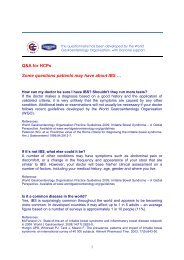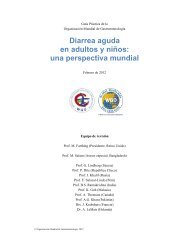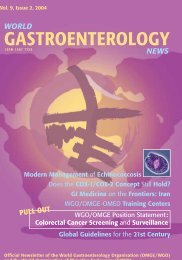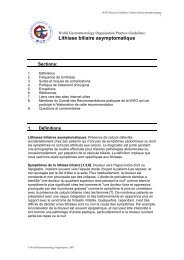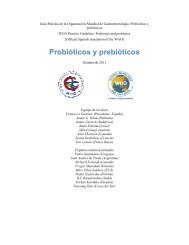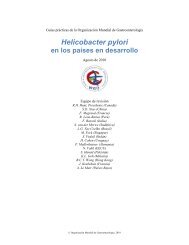Diverticular disease - World Gastroenterology Organisation
Diverticular disease - World Gastroenterology Organisation
Diverticular disease - World Gastroenterology Organisation
Create successful ePaper yourself
Turn your PDF publications into a flip-book with our unique Google optimized e-Paper software.
WGO Practice Guidelines <strong>Diverticular</strong> <strong>disease</strong> 1<br />
<strong>World</strong> <strong>Gastroenterology</strong> <strong>Organisation</strong> Practice Guidelines:<br />
<strong>Diverticular</strong> Disease<br />
Core review team:<br />
Dr. T. Murphy<br />
Prof. R.H. Hunt<br />
Prof. M. Fried<br />
Dr. J.H. Krabshuis<br />
Contents<br />
1 Definitions<br />
2 Epidemiology<br />
3 Etiology<br />
4 Pathophysiology<br />
5 Medical and surgical management<br />
6 Other forms of diverticular <strong>disease</strong><br />
7 Global aspects<br />
8 References<br />
9 Useful web sites<br />
10 WGO Practice Guidelines Committee members who contributed to this<br />
guideline<br />
11 Queries and feedback<br />
1 Definitions<br />
Diverticulum:<br />
• A sac-like protrusion of mucosa through the muscular colonic wall [1].<br />
• Protrusion occurs in weak areas of the bowel wall through which blood vessels<br />
can penetrate.<br />
• Typically 5–10 mm in size.<br />
• Diverticula are really pseudodiverticular (false diverticula), as they contain only<br />
mucosa and submucosa covered by serosa.<br />
<strong>Diverticular</strong> <strong>disease</strong> consists of:<br />
• Diverticulosis: the presence of diverticula within the colon<br />
• Diverticulitis: inflammation of a diverticulum<br />
• <strong>Diverticular</strong> bleeding<br />
Types of diverticular <strong>disease</strong>:<br />
© <strong>World</strong> <strong>Gastroenterology</strong> <strong>Organisation</strong>, 2007
WGO Practice Guidelines <strong>Diverticular</strong> <strong>disease</strong> 2<br />
• Simple (75%), with no complications<br />
• Complicated (25%), with abscesses, fistula, obstruction, peritonitis, and sepsis<br />
2 Epidemiology<br />
Prevalence by age [1]:<br />
• Age 40: 5%<br />
• Age 60: 30%<br />
• Age 80: 65%<br />
Prevalence by sex:<br />
• Age < 50: more common in males<br />
• Age 50–70: slight preponderance in women<br />
• Age > 70: more common in women<br />
<strong>Diverticular</strong> <strong>disease</strong> in the young (< 40)<br />
<strong>Diverticular</strong> <strong>disease</strong> is far more frequent in older people, with only 2–5% of cases<br />
occurring in those under 40 years of age. In this younger age group, diverticular<br />
<strong>disease</strong> occurs more frequently in males, with obesity being a major risk factor<br />
(present in 84–96% of cases) [2,3]. The diverticula are usually located in the sigmoid<br />
and/or descending colon.<br />
Management of this subset of diverticular <strong>disease</strong> patients remains somewhat<br />
controversial. The concept of diverticular <strong>disease</strong> being a more virulent condition in<br />
the young remains widely debated. The natural history still shows a trend towards<br />
recurrent symptoms [4] and an increased incidence of poor outcomes ultimately<br />
requiring surgery [5]. Surgery is often the treatment of choice for young symptomatic<br />
patients (approximately 50% compared with 30% for all patients).<br />
In young patients with no co-morbid conditions, elective surgery after a single<br />
episode of diverticulitis is still a reasonable recommendation.<br />
3 Etiology<br />
Low alimentary fiber was first described as a possible etiologic agent for the<br />
development of diverticular <strong>disease</strong> by Painter and Burkitt in the late 1960s [6,7].<br />
Although this initially met with some resistance, its role in the condition was<br />
demonstrated by publications such as the Health Care Professionals Follow-Up Study<br />
[8].<br />
• The relative risk of developing diverticular <strong>disease</strong> is 0.58 for men with low<br />
alimentary fiber.<br />
• <strong>Diverticular</strong> <strong>disease</strong> is less common in vegetarians [9].<br />
The present theory that fiber is a protective agent against the development of<br />
diverticula and subsequent diverticulitis holds that insoluble fiber causes the<br />
© <strong>World</strong> <strong>Gastroenterology</strong> <strong>Organisation</strong>, 2007
WGO Practice Guidelines <strong>Diverticular</strong> <strong>disease</strong> 3<br />
formation of more bulky stool, which leads to decreased effectiveness in colonic<br />
segmentation. The overall result is that intracolonic pressure remains close to the<br />
normal range during colonic peristalsis [1,10].<br />
Development of diverticular <strong>disease</strong>. There is no evidence of a relationship between<br />
the development of diverticula and smoking, caffeine, and alcohol consumption.<br />
However, an increased risk of developing diverticular <strong>disease</strong> is associated with a diet<br />
that is high in red meat and total fat content. This risk can be reduced by a diet high in<br />
fiber content, especially if it is of a cellulose origin (fruits and vegetables) [11].<br />
Risk of complications. Complicated diverticular <strong>disease</strong> has been noted with<br />
increased frequency in patients who smoke, use non-steroidal anti-inflammatory drugs<br />
and acetaminophen (especially paracetamol) and those who are obese and have lowfiber<br />
diets [12]. Complicated diverticular <strong>disease</strong> is not more common in patients who<br />
drink alcohol or caffeinated beverages.<br />
Location of diverticular <strong>disease</strong>. The most typical form is a pseudodiverticulum or<br />
pulsion diverticulum (a diverticulum does not contain all the layers of the colonic<br />
wall; the mucosa and submucosa herniate through the muscle layer and are covered<br />
by serosa). There are four well-defined points around the circumference of the bowel<br />
at which the vasa recta penetrate the circular muscle layer. The vessels enter the wall<br />
on each side of the mesenteric teniae and on the mesenteric border of two<br />
antimesenteric teniae. Diverticula do not form distal to the rectosigmoid junction,<br />
below which the teniae coalesce to form a longitudinal muscle layer.<br />
Distribution [1]. There is sigmoid involvement in 95% of cases; involvement of the<br />
sigmoid alone in 65%; involvement of the entire colon in 7%; and the diverticulum is<br />
located near the sigmoid (but with a normal sigmoid) in 4% of cases.<br />
Natural history. Diverticulosis is symptomatic in 70% of cases; leads to<br />
diverticulitis in 15–25%; and is associated with bleeding in 5–15% [1].<br />
4 Pathophysiology<br />
Diverticulosis<br />
The vasa recta penetrating the bowel wall create areas of weakness through which a<br />
portion of the colonic mucosa and submucosa (covered by serosa) can herniate.<br />
Segmentation can occur as a result of raised intracolonic pressure in certain areas of<br />
the colon. Such segmentation represents strong muscular contractions of the colonic<br />
wall, which serve to propel the luminal content or to halt the passage of material.<br />
Individual chamber pressures are temporarily elevated above those found when the<br />
colonic lumen is unsegmented. Segmentation in diverticulosis is exaggerated, causing<br />
occlusion of both “ends” of the chamber and resulting in high intra-chamber pressures<br />
[1].<br />
The sigmoid is commonly affected, probably due to its small diameter. Laplace’s<br />
law explains their development, with the equation P = kT/R. Most complications are<br />
therefore also located in this area. In the sigmoid and other segments, the bowel<br />
becomes non-compliant in diverticular <strong>disease</strong> through several mechanisms:<br />
© <strong>World</strong> <strong>Gastroenterology</strong> <strong>Organisation</strong>, 2007
WGO Practice Guidelines <strong>Diverticular</strong> <strong>disease</strong> 4<br />
• Mycosis — thickened circular muscle layer, shortening of the teniae, and luminal<br />
narrowing.<br />
• Elastin — increased elastin deposition between muscle cells and teniae coli.<br />
Elastin is also laid down in a contracted form that causes shortening of THE<br />
teniae and bunching of THE circular muscle.<br />
• Collagen — connective-tissue <strong>disease</strong>s such as Ehlers–Danlos syndrome,<br />
Marfan’s syndrome, and autosomal-dominant polycystic kidney <strong>disease</strong> result in<br />
structural changes in the bowel wall, leading to decreased resistance of the wall<br />
to intraluminal pressures and thus allowing protrusion of diverticula.<br />
Diverticulitis<br />
This term represents a spectrum of inflammatory changes, ranging from subclinical<br />
local inflammation to generalized peritonitis with free perforation. The mechanism of<br />
developing diverticulitis centers around the perforation of a diverticulum, whether it<br />
be microscopic or macroscopic. The old luminal obstruction concept is probably a<br />
rare occurrence. Increased intraluminal pressure or inspissated food particles may<br />
erode the diverticular wall with resultant inflammation and focal necrosis, leading to<br />
perforation (micro/macro). The clinical manifestation of the perforation depends on<br />
the size of the perforation and how vigorously it is walled off by the body.<br />
Perforations that are well controlled result in the formation of an abscess, while<br />
incomplete localization may present with free perforation.<br />
• Simple diverticulitis: 75% of cases<br />
• Complicated diverticulitis: 25% of cases (abscess, fistula, or perforation)<br />
Diagnosis. The majority of patients have left lower quadrant pain. An element of<br />
rebound tenderness implies some degree of peritoneal involvement. Fever and<br />
leukocytosis are other important but nonspecific findings.<br />
Examination. The examination may be relatively unremarkable, but most<br />
commonly reveals abdominal tenderness or a mass. Urinary symptoms may further<br />
suggest a pelvic phlegmon.<br />
Differential diagnosis:<br />
• Carcinoma of the bowel — pyelonephritis<br />
• Inflammatory bowel <strong>disease</strong> — appendicitis<br />
• Ischemic colitis<br />
• Irritable bowel syndrome<br />
• Pelvic inflammatory <strong>disease</strong><br />
Investigations:<br />
• Chest/abdominal radiography usually shows no specific findings for diverticular<br />
<strong>disease</strong>, but a pneumoperitoneum can be seen in 11% of patients with acute<br />
diverticulitis.<br />
• The abdominal radiograph is found to be abnormal in 30–50% of patients with<br />
acute diverticulitis.<br />
© <strong>World</strong> <strong>Gastroenterology</strong> <strong>Organisation</strong>, 2007
WGO Practice Guidelines <strong>Diverticular</strong> <strong>disease</strong> 5<br />
• The most common findings include:<br />
— Small-bowel and large-bowel dilation or ileus<br />
— Bowel obstruction<br />
— Soft-tissue densities suggestive of abscesses [13,14]<br />
A diagnosis that is made solely on a clinical basis will be incorrect in 33% of cases.<br />
From the investigational standpoint, computed tomography (CT) is better than<br />
ultrasound. Diverticulitis is often regarded as a predominantly extraluminal disorder,<br />
and CT offers the benefit of evaluating both the bowel and the mesentery with a<br />
sensitivity of 69–98% and a specificity of 75–100%. The CT findings most commonly<br />
noted in acute diverticulitis include:<br />
• Thickening of the bowel wall<br />
• Streaky mesenteric fat<br />
• Associated abscess [1]<br />
In a series of 42 patients with diverticulitis, the following CT findings were noted<br />
[15]:<br />
• Inflamed periodic fat: 98%<br />
• Diverticula: 84%<br />
• Thickened bowel wall: 70%<br />
• Pericolic abscess: 35%<br />
• Peritonitis: 16%<br />
• Fistula: 14%<br />
• Colonic obstruction: 12%<br />
• Intramural sinus tracts: 9%<br />
Other investigations:<br />
• Ultrasound findings may include thickening of the colonic wall and cystic<br />
masses.<br />
• Contrast enema: the use of a contrast enema in the acute setting is mainly<br />
reserved for situations in which the diagnosis is not clear. The enema has a<br />
sensitivity of 62–94%, with a false-negative rate of 2–15%. Meglumine<br />
diatrizoate is a hyperosmolar contrast agent that may assist in relieving partial<br />
obstruction if present.<br />
• Endoscopy, proctosigmoidoscopy, flexible sigmoidoscopy. The use of<br />
endoscopy, involving air insufflation, is relatively contraindicated in the acute<br />
setting due to the increased chance of perforation.<br />
Obstruction<br />
• Complete colonic obstruction due to diverticular <strong>disease</strong> is relatively rare,<br />
accounting for approximately 10% of large-bowel obstructions.<br />
• Partial obstruction is a more common finding and results from a combination of<br />
edema, bowel spasm, and chronic inflammatory changes.<br />
• Acute diverticulitis can lead to partial bowel obstruction due to edema (colonic,<br />
pericolonic) or compression from an abscess.<br />
© <strong>World</strong> <strong>Gastroenterology</strong> <strong>Organisation</strong>, 2007
WGO Practice Guidelines <strong>Diverticular</strong> <strong>disease</strong> 6<br />
• Recurrent progressive fibrosis and/or stricturing of the bowel may lead to highgrade<br />
or complete obstruction (it is often difficult, but important, to distinguish<br />
between a diverticulum-induced stricture and neoplasm).<br />
Abscess<br />
• The formation of a complicated diverticular abscess depends on the ability of the<br />
pericolic tissues to control (localize) the spread of the inflammatory process.<br />
• In general, intra-abdominal abscesses are formed by:<br />
— Anastomosis leakage: 35%<br />
— <strong>Diverticular</strong> <strong>disease</strong>: 23%<br />
• Limited spread of the perforation forms a phlegmon, while further (but still<br />
localized) progression creates an abscess.<br />
• Signs and symptoms: fever with or without leukocytosis despite adequate<br />
antibiotics, tender mass.<br />
• Treatment:<br />
— Small pericolic abscess: 90% will respond to antibiotics and conservative<br />
management alone.<br />
— Percutaneous abscess drainage (PAD) is the treatment of choice for small,<br />
simple, well-defined collections. A group at the University of Minnesota<br />
published an overall success rate for PAD of 76%.<br />
— 100% of simple unilocular abscesses resolved with PAD and antibiotic<br />
therapy. Factors identified as limiting the success of this management strategy<br />
include: multilocular collection, abscesses associated with enteric fistulas, and<br />
abscesses containing solid or semisolid material [16].<br />
Perforation (free perforation)<br />
Free perforation is fortunately uncommon. It occurs more frequently in the<br />
immunocompromised patient. Free perforation is associated with the highest mortality<br />
rate, in up to 35% of cases. Urgent surgical intervention is required in most cases.<br />
Fistulas<br />
Fistulas occur in 2% of patients with complicated diverticular <strong>disease</strong>. The formation<br />
of the fistula results from a local inflammatory process that results in an abscess,<br />
which spontaneously decompresses by perforating into an adjacent viscus or through<br />
the skin. The fistulous tract is commonly single, but multiple tracts are found in 8% of<br />
patients.<br />
Fistula are more frequent in men than in women (2 : 1); in patients with previous<br />
abdominal surgery; and in immunocompromised patients.<br />
Types of fistula related to diverticular <strong>disease</strong>:<br />
• Colovesical: 65%<br />
• Colovaginal: 25%<br />
• Colocutaneous: data not available<br />
• Coloentero: data not available<br />
© <strong>World</strong> <strong>Gastroenterology</strong> <strong>Organisation</strong>, 2007
WGO Practice Guidelines <strong>Diverticular</strong> <strong>disease</strong> 7<br />
Diagnosis. The diagnosis of fistulas may require multiple investigations, but they<br />
are most commonly identified with CT, barium enema, vaginoscopy, cystoscopy, or<br />
fistulography.<br />
Trends. A group at Yale noted the following trends with regard to intra-abdominal<br />
fistulae:<br />
• Fistula from diverticular <strong>disease</strong> — older patients with pneumaturia<br />
• Fistula from neoplasms — fecaluria, gastrointestinal symptoms, and hematuria<br />
• Fistula from Crohn’s <strong>disease</strong> — younger patients, pain, abdominal mass,<br />
pneumaturia [16]<br />
Bleeding<br />
Apart from hemorrhoids and other nonneoplastic perianal disorders, colorectal cancer<br />
is the most common cause of lower gastrointestinal bleeding. <strong>Diverticular</strong> <strong>disease</strong><br />
remains the most common cause of massive lower gastrointestinal bleeding,<br />
accounting for 30–50% of cases. It is estimated that 15% of patients with<br />
diverticulosis will bleed at some time in their lives. The bleeding is usually abrupt,<br />
painless, and large in volume, with 33% being massive, requiring emergency<br />
transfusion [1].<br />
Despite this, bleeding stops spontaneously in 70–80% of cases. Nonsteroidal antiinflammatory<br />
drugs (NSAIDs) have been shown to increase the risk of bleeding from<br />
diverticular <strong>disease</strong>, with over 50% of patients with bleeding diverticula receiving<br />
NSAID treatment at the time of presentation. Angiodysplasia accounts for 20–30% of<br />
lower intestinal bleeding.<br />
Mechanism. <strong>Diverticular</strong> <strong>disease</strong> is responsible for colonic bleeding because as a<br />
diverticulum herniates, the penetrating vessels responsible for the bowel wall<br />
weakness become draped over the dome of the diverticulum. In this configuration,<br />
these vessels are only separated from the bowel lumen by a thin mucosal lining. The<br />
artery is thus exposed to injury from luminal contents, and bleeding occurs [1].<br />
Histologic examination of these ruptured vessels reveals an architecture in keeping<br />
with this theory of diverticular bleeding. Asymmetric rupture of the vas rectum (the<br />
vessel draped over the diverticulum) occurs towards the lumen of the diverticulum at<br />
its dome on the antimesenteric margin. Injurious factors within the colonic lumen<br />
produce asymmetric damage on the luminal aspect of the underlying vas rectum,<br />
resulting in segmental weakness of the artery and predisposition to rupture into the<br />
lumen. Rupture is associated with eccentric thickening of the intima of the vessels and<br />
thinning of the media near the bleeding point. There is also a notable absence of<br />
inflammation (diverticulitis) in this process [1].<br />
Although the anatomic relationship between the penetrating vessels and the<br />
diverticula is similar on both the right and left sides of the colon, the right colon is the<br />
source of bleeding in 49–90% of patients [17–19]. In those with an initial episode of<br />
bleeding, 30% go on to have a second bleed, and of those 50% will have a third bleed.<br />
The source of bleeding is not identified in up to 30–40% of cases. Methods of<br />
locating the area of hemorrhage include:<br />
© <strong>World</strong> <strong>Gastroenterology</strong> <strong>Organisation</strong>, 2007
WGO Practice Guidelines <strong>Diverticular</strong> <strong>disease</strong> 8<br />
• Selective angiography:<br />
— The minimum rate needed is 1.0–1.3 mL/min.<br />
— This modality has the advantage of allowing interventional therapy to be<br />
carried out in the form of vasopressin, somatostatin; embolization; and marking<br />
the area with methylene blue for future investigation.<br />
• Radioisotope scanning:<br />
— Bleeding can be detected at rates as low as 0.1 mL/min.<br />
— Several types of isotope can be used, including: 99m technetium-labeled sulfur<br />
colloid, which clears within minutes, pools in the lumen, and has the advantage<br />
of only taking a short time to complete the study; and labeled red blood cells,<br />
which have a longer circulating half-life and allow scans to be repeated for up to<br />
24–36 hours.<br />
The accuracy of bleeding studies varies widely, from 24% to 91%.<br />
Colonoscopy:<br />
• Colonoscopy is best reserved for self-limited bleeding. In patients with moderate<br />
bleeding that has stopped, colonoscopy can be safely done within 12–24 hours.<br />
• In patients with less severe bleeding, colonoscopy is a reasonable option as an<br />
outpatient procedure.<br />
• Colonoscopy continues to be an important investigation for excluding neoplasm<br />
(32%) and carcinoma (19%) as the source of bleeding.<br />
• Emergency colonoscopy after aggressive bowel lavage has been suggested by<br />
several authors [20,21]. Therapeutic interventions, with local injection of<br />
epinephrine or sclerosant or thermocoagulation of specific bleeding diverticula<br />
that are identified may lead to decreased rebleeding rates in the early phase. The<br />
presence of other diverticula and their inherent propensity to bleed makes acute<br />
endoscopic intervention unlikely to affect the overall rebleeding rates in the<br />
longer term.<br />
Urgent surgery for bleeding. Urgent surgery for diverticulum-related bleeding only<br />
controls bleeding in 90% of patients. Indications for urgent surgical intervention<br />
include:<br />
• Hemodynamic instability not responsive to conventional resuscitation techniques<br />
• Transfusion of blood > 2000 mL (approximately six units)<br />
• Recurrent massive hemorrhage<br />
5 Medical and surgical management<br />
Medical management (diverticulitis)<br />
Outpatient treatment. Patients with mild abdominal pain/tenderness and no systemic<br />
symptoms:<br />
• Acute low-residue diet.<br />
• Antibiotics for 7–14 days (amoxicillin/clavulanic acid, sulfamethoxazoletrimethoprim,<br />
or quinolone + metronidazole for 7–10 days).<br />
© <strong>World</strong> <strong>Gastroenterology</strong> <strong>Organisation</strong>, 2007
WGO Practice Guidelines <strong>Diverticular</strong> <strong>disease</strong> 9<br />
• After initiation of therapy, expect improvement in 48–72 hours.<br />
• It is important to cover for Escherichia coli and Bacteroides fragilis.<br />
• If there is no improvement in 48–72 hours, look for a collection intraabdominally.<br />
In-patient treatment: Patients with severe signs/symptoms (1–2% of cases):<br />
• Admit the patient to hospital.<br />
• Ensure bowel rest.<br />
• Intravenous antibiotics (Gram-negative and anaerobic coverage) for 7–10 days<br />
• Intravenous fluids<br />
• Analgesia (meperidine). Meperidine is preferable to morphine, as the latter may<br />
lead to increased intracolonic pressure in the sigmoid.<br />
• If there is improvement within 48 hours, then continue management, starting a<br />
low-residue diet in the acute period. Antibiotics may be switched to the oral form<br />
if the patient is afebrile for 24–48 hours and there is a decreasing white blood cell<br />
trend.<br />
• If there is no improvement, phlegmon or a collection (abscess) should be<br />
suspected and investigated accordingly.<br />
Some 15–30% of patients admitted for the management of diverticulitis will require<br />
surgery during admission, with an associated mortality rate of 18%.<br />
Investigations<br />
• Barium enema is inaccurate in 32% of cases of acute diverticulitis.<br />
• Colonoscopy in the acute setting is associated with a theoretical increase in the<br />
risk of colonic perforation, due to insufflation of air during the procedure. For<br />
this reason, this investigation is often not used. Technical difficulties with<br />
colonoscopy in diverticular <strong>disease</strong> include:<br />
— Bowel spasm<br />
— Luminal narrowing due to prominent folds<br />
— Fixation of the colon due to previous inflammation, pericolic fibrosis<br />
Surgical management (diverticulitis)<br />
Between 22% and 30% of patients with an initial episode of diverticulitis will go on<br />
to have a second episode [22]. Urgent surgical intervention is mandatory if<br />
complications occur, which include:<br />
• Free perforation with generalized peritonitis<br />
• Obstruction<br />
• Abscess not amenable to percutaneous drainage<br />
• Fistulas<br />
• Clinical deterioration or failure to improve with conservative management [1]<br />
Elective surgery is a more common scenario. Surgery is undertaken after adequate<br />
bowel preparation has been performed. The indications for surgery most frequently<br />
reported include:<br />
© <strong>World</strong> <strong>Gastroenterology</strong> <strong>Organisation</strong>, 2007
WGO Practice Guidelines <strong>Diverticular</strong> <strong>disease</strong> 10<br />
• Two or more episodes of diverticulitis severe enough to cause hospitalization<br />
• Any episode of diverticulitis associated with contrast leakage (Ba), obstructive<br />
symptoms, or an inability to differentiate between diverticulitis and cancer<br />
Resection is usually carried out 6–8 weeks after any acute episode of inflammation.<br />
The surgical options vary depending on whether the indication is urgent or elective.<br />
Elective surgery most commonly involves resection of the sigmoid colon. Resection is<br />
performed after mechanical and antibiotic bowel preparation has been completed. The<br />
procedure can be performed either as an open procedure or laparoscopically.<br />
Inflammation and scarring may technically preclude the laparoscopic route.<br />
There are numerous options exist for urgent surgical intervention in patients with<br />
acute diverticulitis and its complications. Controversy with regard to the surgical<br />
options historically involved the need for primary resection at the initial operation and<br />
performing a staged procedure, as against a single operative plan. Primary resection is<br />
now the accepted standard and has been shown by a number of studies to be:<br />
• Associated with a shorter hospital stay [23,24]<br />
• Associated with reduced morbidity than with colostomy alone and drainage<br />
[25,26]<br />
• Associated with a lower mortality than with colostomy alone versus resection<br />
(26% vs. 7%)<br />
• Associated with a survival advantage [27]<br />
Hartmann’s procedure, originally described in 1923 [28], was initially intended for<br />
the treatment of cancer of the rectum. It represents a staged procedure in which the<br />
sigmoid colon is mobilized and resected, with the rectum being closed and a<br />
colostomy formed. The colostomy is closed at a later date (often around 3 months<br />
postoperatively), with restoration of bowel continuity. This staged procedure posed<br />
problems, including a second operation, rectal scarring, and difficulty in completing<br />
the anastomosis.<br />
Transverse colostomy and drainage is another staged procedure (without primary<br />
resection) in which an initial colostomy is formed, followed by resection of the<br />
<strong>disease</strong>d segment and later closure of the colostomy. This procedure is associated<br />
with a morbidity rate of 12% and a mortality rate of 5–29% [27,29,30].<br />
The concept of primary anastomosis arose out of the inherent problems with staged<br />
revision of the Hartmann procedure. Primary anastomosis is the preferred procedure<br />
in the majority of patients with adequate bowel preparation, but is contraindicated if<br />
the patient is unstable, has feculent peritonitis, or is severely malnourished or<br />
immunocompromised.<br />
Resection with primary anastomosis and proximal stoma is a modified procedure<br />
used on an individualized basis. It allows easier reversal of the colostomy via a less<br />
invasive second (staged) operation. A single-stage procedure with on-table gut lavage<br />
can also be used in the acute setting to allow for primary anastomosis of a less than<br />
ideally prepared bowel.<br />
© <strong>World</strong> <strong>Gastroenterology</strong> <strong>Organisation</strong>, 2007
WGO Practice Guidelines <strong>Diverticular</strong> <strong>disease</strong> 11<br />
6 Other forms of diverticular <strong>disease</strong><br />
Recurrent diverticulitis after resection<br />
• Recurrent diverticulitis after resection is rare, ranging from 1% to 10%. In<br />
general, the progression of diverticular <strong>disease</strong> in the remaining colon is<br />
approximately 15%.<br />
• The reoperation rate for diverticular <strong>disease</strong> ranges from 2% to 11% and depends<br />
on the procedure chosen at the time of resection. The use of the rectum as the<br />
distal margin decreases the rate of recurrence (in comparison with the sigmoid as<br />
the margin).<br />
• Care must be taken to exclude other causes of symptoms/signs suggestive of<br />
diverticular <strong>disease</strong>, such as irritable bowel syndrome (IBS) or ischemic colitis.<br />
Important associations:<br />
• Diverticulitis and Crohn’s <strong>disease</strong> — especially in the aged<br />
• Diverticulosis and IBS<br />
• Up to 30% of diverticular <strong>disease</strong> patients have IBS<br />
Right-sided diverticulitis<br />
Diverticulosis in Asia is predominantly a right-sided phenomenon, occurring in 35–<br />
84% of cases. The early age of onset suggests a genetic basis, although this is still<br />
under investigation. Right-sided diverticular <strong>disease</strong> is also more commonly<br />
associated with multiple diverticula, while right-sided diverticular <strong>disease</strong> in the<br />
Western hemisphere is usually a single diverticulum.<br />
Diagnosis. Right-sided symptomatic diverticular <strong>disease</strong> can be difficult to<br />
distinguish from appendicitis. It may present with:<br />
• Right upper quadrant pain.<br />
• Nausea, emesis, fever.<br />
• An abdominal mass is found in 26–88% of patients on clinical examination<br />
• Leukocytosis is commonly present, but is a nonspecific finding. CT is able to<br />
diagnose appendicitis with a sensitivity of 98% and a specificity of 98%.<br />
Treatment. The treatment of right-sided diverticular <strong>disease</strong> follows that outlined<br />
under the heading of medical management above (section 5). Surgical options are as<br />
outlined above, but may also include a diverticulotomy for <strong>disease</strong> confined to a focal<br />
area or a right hemicolectomy.<br />
Subacute diverticulitis<br />
Subacute diverticulitis represents moderate to severe episodes of diverticulitis with<br />
some resolution on antibiotics and conservative treatment, but which does not resolve<br />
completely. The problem continues in a smoldering fashion with low-grade fever, left<br />
lower quadrant pain, and altered bowel habit.<br />
© <strong>World</strong> <strong>Gastroenterology</strong> <strong>Organisation</strong>, 2007
WGO Practice Guidelines <strong>Diverticular</strong> <strong>disease</strong> 12<br />
Smoldering diverticulitis<br />
Smoldering diverticulitis consists of abdominal pain and a change in bowel habit,<br />
without obvious fever or leukocytosis. This condition can persist for 6–12 months.<br />
The condition is often diagnosed by the presence of:<br />
• Chronic left lower quadrant pain<br />
• Diverticulosis on history and investigations<br />
• An absence of signs of diverticulitis<br />
Treatment. Sigmoid resection provides complete resolution in 70% of cases.<br />
<strong>Diverticular</strong> <strong>disease</strong> in the immunocompromised patient<br />
Conditions that represent an immunocompromised state include:<br />
• Severe infection<br />
• Steroids<br />
• Diabetes mellitus<br />
• Renal failure (45–50% of patients)<br />
• Malignancy<br />
• Cirrhosis<br />
• Chemotherapy/immunosuppressive agents (13%)<br />
The clinical findings are usually very subtle. The condition is associated with:<br />
• An increased rate of free perforation (43% vs. 14% in immunocompetent<br />
patients)<br />
• An increased need for surgery (58% vs. 33%)<br />
• Increased postoperative mortality (39% vs. 2%)<br />
Giant diverticulum (colon)<br />
This is a rare condition, first described by Bonvin and Bronte in 1942.<br />
• Sex: as frequent in men as in women.<br />
• Age: usually occurs in patients over the age of 50.<br />
• Size: must have a diameter > 13 cm<br />
• Location: the sigmoid is almost exclusively involved.<br />
• Mechanism: there is a ball-valve effect, with air being trapped in the diverticulum<br />
• Types: type 1 is a pseudodiverticulum, type 2 is a true diverticulum.<br />
7 Global aspects<br />
Geographic variation<br />
In the developed world, the prevalence of diverticular <strong>disease</strong> ranges from 5% to<br />
45%. The majority of this population (90%) is made up of patients with distal bowel<br />
<strong>disease</strong>. Only 1.5% of cases involve solely the right side of the large bowel [10].<br />
© <strong>World</strong> <strong>Gastroenterology</strong> <strong>Organisation</strong>, 2007
WGO Practice Guidelines <strong>Diverticular</strong> <strong>disease</strong> 13<br />
In contrast, individuals in Africa and Asia who develop diverticular <strong>disease</strong> have<br />
predominantly right-colon involvement (70–74%), especially in the ascending colon.<br />
In Singapore, only 23% of patients have sigmoid involvement, and 70% of those<br />
with right-sided diverticulosis are under 40 years of age [22,31]. The early age of<br />
onset and the location suggest a genetic basis for the development of diverticular<br />
<strong>disease</strong> in Asia, but this requires further investigation.<br />
Despite the increasing westernization of the diet, Japan still has a higher prevalence<br />
of right-sided diverticular <strong>disease</strong> (although cases involving the left colon are<br />
increasing).<br />
Hong Kong still has a 76% prevalence of right-sided diverticulosis.<br />
8 References<br />
1 Young-Fadok TM, Roberts PL, Spencer MP, Wolff BG. Colonic diverticular <strong>disease</strong>. Curr Prob<br />
Surg 2000;37:457–514 (PMID: 10932672).<br />
2 Schauer PR, Ramos P, Ghiatas AA, Sirinek KR. Virulent diverticular <strong>disease</strong> in young obese<br />
men. Am J Surg1992;164:443–8 (PMID: 1443367).<br />
3 Konvolinka CW. Acute diverticulitis under age forty. Am J Surg 1994;167:562–5 (PMID:<br />
8209928).<br />
4 Ambrosetti P, Robert JH, Witzig JA, Mirescu D, Mathey P, Borst F, et al. Acute left colonic<br />
diverticulitis in young patients. J Am Coll Surg 1994;179:156–60 (PMID: 8044384).<br />
5 Anderson DN, Driver CP, Davidson AI, Keenan RA. <strong>Diverticular</strong> <strong>disease</strong> in patients under<br />
50 years of age. J R Coll Surg Edinb 1997;42:102–4 (PMID: 9114680).<br />
6 Painter NS, Burkitt DP. <strong>Diverticular</strong> <strong>disease</strong> of the colon, a 20th century problem. Clin<br />
Gastroenterol 1975;4:3–21 (PMID: 1109818).<br />
7 Painter NS. The cause of diverticular <strong>disease</strong> of the colon, its symptoms and complications:<br />
review and hypothesis. J R Col Surg Edinb 1985;30:118–22 (PMID: 2991507).<br />
8 Talbot JM. Role of dietary fiber in diverticular <strong>disease</strong> and colon cancer. Fed Proc<br />
1981;40:2337–42 (PMID: 6265284).<br />
9 Nair P, Mayberry JF. Vegetarianism, dietary fibre and gastro-intestinal <strong>disease</strong>. Dig<br />
Dis1994;12:177–85 (PMID: 7988064).<br />
10 Stollman NH, Raskin JB. <strong>Diverticular</strong> <strong>disease</strong> of the colon. J Clin Gastroenterol 1999;29:241–52<br />
(PMID: 10509950).<br />
11 Aldoori WH, Giovannucci EL, Rimm EB, Wing AL, Trichopoulos DV, Willet WC. A<br />
prospective study of alcohol, smoking, caffeine, and the risk of symptomatic diverticular <strong>disease</strong><br />
in men. Ann Epidemiol 1995;5:221–8 (PMID: 7606311).<br />
12 Aldoori WH, Giovannucci EL, Rimm EB, Wing AL, Willett WC. Use of acetaminophen and<br />
nonsteroidal anti-inflammatory drugs: a prospective study and the risk of symptomatic<br />
diverticular <strong>disease</strong> in men. Arch Fam Med 1998;7:255–60 (PMID: 9596460).<br />
13 Kourtesis GJ, Williams RA, Wilson SE. Surgical options in acute diverticulitis: value of sigmoid<br />
resection in dealing with the septic focus. Aust N Z J Surg 1988;58:955–9 (PMID: 3202729).<br />
14 Morris J, Stellato TA, Lieberman J, Haaga JR. The utility of computed tomography in colonic<br />
diverticulitis. Ann Surg 1986;204:128–32 (PMID: 3741003).<br />
15 Hulnick DH, Megibow AJ, Balthazar EJ, Naidich DP, Bosniak MA. Computed tomography in<br />
the evaluation of diverticulitis. Radiology 1984;152:491–5 (PMID: 6739821).<br />
© <strong>World</strong> <strong>Gastroenterology</strong> <strong>Organisation</strong>, 2007
WGO Practice Guidelines <strong>Diverticular</strong> <strong>disease</strong> 14<br />
16 Pontari MA, McMillen MA, Garvey RH, Ballantyne GH. Diagnosis and treatment of<br />
enterovesical fistulae. Am Surg 1992;58:258–63 (PMID: 1586086).<br />
17 Gostout CJ, Wang KK, Ahlquist DA, Clain JE, Hughes RW, Larson MV, et al. Acute<br />
gastrointestinal bleeding: experience of a specialized management team. J Clin Gastroenterol<br />
1992;14:260–7 (PMID: 1564303).<br />
18 Meyers MA, Volberg F, Katzen B, Alonso D, Abbott G. The angioarchitecture of colonic<br />
diverticula: significance in bleeding diverticulosis. Radiology 1973;108:249–61 (PMID:<br />
4541643).<br />
19 Caserella WJ, Kanter IE, Seaman WB. Right-sided colonic diverticula as a cause of acute rectal<br />
hemorrhage. N Eng J Med 1972;286:450–3 (PMID: 4536683).<br />
20 Jensen DM, Machicado GA, Jutabha R, Kovacs TO. Urgent colonoscopy for the diagnosis and<br />
treatment of severe diverticular hemorrhage. N Engl J Med 2000;342:78–82 (PMID: 10631275).<br />
21 Bloomfield RS, Rockey DC, Shetzline MA. Endoscopic therapy of acute diverticular<br />
hemorrhage. Am J Gastroenterol 2001;96:2367–72 (PMID: 11513176).<br />
22 Lee YS. <strong>Diverticular</strong> <strong>disease</strong> of the large bowel in Singapore: an autopsy survey. Dis Colon<br />
Rectum 1986;29:330–5 (PMID: 3084185).<br />
23 Rodkey GV, Welch CE. Changing patterns in the surgical treatment of diverticular <strong>disease</strong>. Ann<br />
Surg 1984;200:466–78 (PMID: 6333217).<br />
24 Aguste L, Barrero E, Wise L. Surgical management of perforated colonic diverticulitis. Arch<br />
Surg 1985;120:450–2 (PMID: 3985790).<br />
25 Finlay IG, Carter DC. A comparison of emergency resection and staged management in<br />
perforated diverticular <strong>disease</strong>. Dis Colon Rectum 1987;30:929–33 (PMID: 3691263).<br />
26 Nagorney DM, Adson MA, Pemberton JH. Sigmoid diverticulitis with perforation and<br />
generalized peritonitis. Dis Colon Rectum 1985;28:71–5.<br />
27 Krukowski ZH, Matheson NA. Emergency surgery for diverticular <strong>disease</strong> complicated by<br />
generalized and faecal peritonitis: a review. Br J Surg 1984;71:921–7 (PMID: 6388723).<br />
28 Hartmann H. Nouveau procédé d’ablation des cancers de la partie terminale du cólon pelvien.<br />
XXX e Congrés Français de Chirurgie, Strasbourg, 1921: 411; cited in: Classic articles in colonic<br />
and rectal surgery. Henri Hartmann 1860–1952. New procedure for removal of cancers of the<br />
distal part of the pelvic colon. Dis Colon Rectum 1984;27:273 (PMID: 6370633).<br />
29 Smithwick RH. Experiences with surgical management of diverticulitis of sigmoid. Ann Surg<br />
1942;115:969–83.<br />
30 Greif JM, Fried G, McSherry CK. Surgical treatment of perforated diverticulitis of the sigmoid<br />
colon. Dis Colon Rectum 1980;23:483–7 (PMID: 7002505).<br />
31 Chia JG, Wilde CC, Ngoi SS, Goh PM Ong CL. Trends of diverticular <strong>disease</strong> of the large bowel<br />
in a newly developed country. Dis Colon Rectum 1991;34:498–501 (PMID: 1645247).<br />
9 Useful web sites<br />
• Standard Taskforce, American Society of Colon and Rectal Surgeons (ASCRS).<br />
Practice Parameters for the Treatment of Sigmoid Diverticulitis. Supporting<br />
documentation guideline by Douglas Wong and Steven D. Wexner. This is a<br />
comprehensive overview of the topic dated March 2000 with 83 references. The<br />
full-text document is available free from the ASCRS web site at:<br />
http://ascrs.affiniscape.com/displaycommon.cfman=1&subarticlenbr=124<br />
• Stollman NH, Raskin JB. Diagnosis and management of diverticular <strong>disease</strong> of<br />
the colon in adults. Ad Hoc Practice Parameters Committee of the American<br />
College of <strong>Gastroenterology</strong>. Am J Gastroenterol 1999;94:3110–21 (PMID:<br />
PMID: 10566700). This is a full overview of the topic for and on behalf of the Ad<br />
© <strong>World</strong> <strong>Gastroenterology</strong> <strong>Organisation</strong>, 2007
WGO Practice Guidelines <strong>Diverticular</strong> <strong>disease</strong> 15<br />
Hoc Practice Parameters Committee of the American College of<br />
<strong>Gastroenterology</strong>, dated July 1999. The document is available for free via the<br />
ACG web site at:<br />
http://www.acg.gi.org/physicians/guidelines/<strong>Diverticular</strong>DiseaseoftheColon.pdf<br />
• Society for Surgery of the Alimentary Tract (SSAT): Surgical Treatment of<br />
Diverticulitis. This patient care guideline is written primarily for primary-care<br />
physicians to assist with decisions on whether or not to refer a patient for surgical<br />
consultation. It is a basic outline dealing with symptoms and diagnosis, treatment,<br />
risks, expected outcome and qualifications for performing surgery for<br />
diverticulitis. The document is available for free from the SSAT web site at:<br />
http://www.ssat.com/cgi-bin/divert.cgi<br />
• American Society of Colon and Rectal Surgeons (ASCRS) annual meeting in San<br />
Diego, California, 3 June 2001: webcast by Tonia Young-Fadok of the Mayo<br />
Medical School on “Core Subjects — <strong>Diverticular</strong> Disease”. Free registration at<br />
www.vioworks.com; go to the ASCRS 2001 Annual Conference lectures area<br />
and choose this one.<br />
10 WGO Practice Guidelines Committee Members who<br />
contributed to this guideline<br />
• Prof. R.N. Allan (Birmingham): Robert.Allan@university-b.wmids.nhs.uk<br />
• Prof. Franco Bazzoli (Bologna): bazzoli@alma.unibo.it<br />
• Dr. Philip Bornman (Cape Town): bornman@curie.uct.ac.za<br />
• Dr. Ding-Shinn Chen (Taipei): gest@ha.mc.ntu.edu.tw<br />
• Dr. Henry Cohen (Montevideo): hcohen@chasque.apc.org<br />
• Prof. A. Elewaut (Ghent): andre.elewaut@rug.ac.be<br />
• Dr. Suliman S. Fedail (Khartoum): fedail@hotmail.com<br />
• Prof. Michael Fried (Zurich): michael.fried@dim.usz.ch<br />
• Prof. Alfred Gangl (Vienna): alfred.gangl@univie.ac.at<br />
• Prof. Joseph E. Geenen (Milwaukee): giconsults@aol.com<br />
• Dr. Saeed S. Hamid (Karachi): saeed.hamid@aku.edu<br />
• Prof. Richard Hunt (Hamilton, Ontario): huntr@fhs.mcmaster.ca<br />
• Prof. Günter J. Krejs (Graz): guenter.krejs@kfunigraz.ac.at<br />
• Prof. Shiu-Kum Lam (Hong Kong): mcwong@hkucc.hku.hk<br />
• Dr. Greger Lindberg (Stockholm): greger.lindberg@medhs.ki.se<br />
• Dr. Hou Yu Liu (Shanghai): hyliu@online.sh.cn<br />
• Prof. Juan-R. Malagelada (Barcelona): malagelada@hg.vhebron.es<br />
• Prof. Peter Malfertheiner (Magdeburg): peter.malfertheiner@medizin.unimagdeburg.de<br />
• Prof. Roque Saenz (Santiago de Chile): schgastr@netline.cl<br />
• Dr. Nobuhiro Sato (Tokyo): nsato@med.juntendo.ac.jp<br />
• Prof. Mahesh V. Shah (Nairobi): mv@wananchi.com<br />
• Dr. Patreek Sharma (Kansas City): psharma@kumc.edu<br />
• Dr. Jose D. Sollano (Manila): jsollano@metro.net.ph<br />
• Prof. Alan B.R. Thomson (Edmonton): alan.thomson@ualberta.ca<br />
• Prof. Guido N. J. Tytgat (Amsterdam): g.n.tytgat@amc.uva.nl<br />
• Dr. Nimish Vakil (Milwaukee): nvakil2001us@yahoo.com<br />
© <strong>World</strong> <strong>Gastroenterology</strong> <strong>Organisation</strong>, 2007
WGO Practice Guidelines <strong>Diverticular</strong> <strong>disease</strong> 16<br />
11 Queries and feedback<br />
The Practice Guidelines Committee welcomes any comments and queries that readers<br />
may have. Do you feel we have neglected some aspects of the topic Do you think<br />
that some procedures are associated with extra risk Tell us about your own<br />
experience. You are welcome to click on the link below and let us know your views.<br />
guidelines@worldgastroenterology.org<br />
© <strong>World</strong> <strong>Gastroenterology</strong> <strong>Organisation</strong>, 2007



